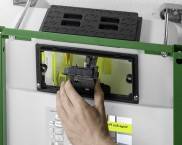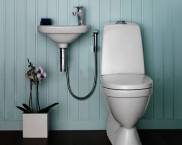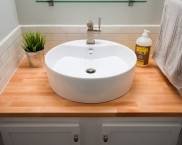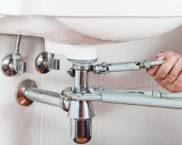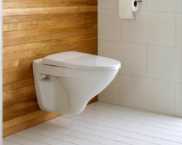Condensation on the toilet cistern - how to get rid of?
The formation of "dew" on the toilet cistern is a problem that occurs during the winter in almost every apartment. The consequences can be different - from small drips and a slight increase in humidity in the bathroom or toilet to the formation of puddles on the floor, the reproduction of mold spores. You can avoid unpleasant consequences by eliminating in advance the condensate on the toilet cistern, how to get rid of which you will learn from this article.
The content of the article
Why do water drips form?
- Ventilation failure
The cause of condensation may be malfunctions in the ventilation system or the absence of a ventilation window (often closed up during repairs in order to improve interior). As a result, proper air circulation is not ensured, and excess moisture settles on surfaces.
- Increased humidity
The location of the bathroom in the bathroom, constant drying of wet linen in the apartment, pipe leaks, a large number of plants in the house cause an overestimated concentration of moisture in the air. If it simply evaporates on pipes, then it settles on plastic and ceramic surfaces, forming drops. On the pages of our portal, you can also find out how to install a toilet bowl on a tiled floor and why it is important.
- Temperature difference
Water for internal filling of the tank is taken from the centralized network. Its temperature is 3 - 5 ° C in winter. Outside room air can reach 25 ° C through the placement of heating pipes. A difference of 10 - 15 ° C is sufficient for condensation to form.
- Drainage device breakage
A malfunction of the shut-off valves leads to the constant filling of the tank with cold water, which goes into the sewer without having time to warm up.
- Excessive water consumption
A similar phenomenon is observed with frequent use of the drain, especially in large families.In addition to the cost, this leads to a stable maintenance of the difference between the temperature outside and inside, therefore, to the appearance of condensation.
Having established the cause of the appearance, consider how to get rid of condensation on the toilet cistern.
Air circulation normalization
First check how effective natural ventilation is. Ventilation windows should be covered with a grill, in no case clogged with dirt and dust.
Many users prefer to leave the bathroom door open, but a better option is to make a gap at the bottom.
Before installing decorative meshes, the channel should be cleaned of debris, if this has not been done, then there is a possibility that there is no traction in the system. In this case, it must be cleaned. In a private house, this duty falls directly on the owner, in multi-storey residential buildings - on the housing office, where you should contact.
Natural ventilation is not always provided by ventilation. In this case, an artificial one should be installed. It is difficult to do this on your own, since you need to take into account the power of the equipment and the state of the microclimate of the room, so we recommend contacting special centers.
There are also systems that dry the air, which are focused on shared bathrooms. They provide a decrease in the degree of humidity by utilizing water vapor.
Temperature balance equalization
There are two ways to achieve approximately the same water temperature in the tank and in the room.
- Decrease in air temperature
Usually the problem occurs in winter, so the first method is not always practical. The result can be achieved by lowering the overall temperature in the system, but then the house will become a few degrees cooler. This has its advantages, because you can save on heating.
With a centralized system, this will not solve the problem. You should take care of the thermal insulation of the pipes near the bathroom, and also make sure that the doors to the room are closed.
Video: tips on how to get rid of condensation in the bathroom
- Heated supply water
If possible, it is recommended to connect a hot water pipe to the tank. The reservoir will automatically be filled with liquid at room temperature, and the likelihood of condensation will be reduced to zero. The best option is to install an electric heater on the tank.
Repair of shut-off valves
Condensation, which forms on stably working toilets, is not so terrible and it is much easier to eliminate. In systems, the drainage mechanism of which is damaged, this phenomenon becomes permanent, because the tank is being refilled with cold water all the time.
Gravity can be determined by the noise of flowing water or visually: the stream does not stop after filling the tank, the tank takes a very long time and does not fill completely.
As a result:
- the humidity in the room rises even more;
- puddles form on the floor;
- dampness leads to mold;
- an unpleasant odor arises.
How to get rid of condensation on the toilet cistern?
In this case, neither ventilation nor air drying will be able to get rid of the problem completely. Gravity can be eliminated on your own, but if the breakdown is serious, it is recommended to call a plumber.
If the reason for the constant filling of the tank, therefore, the inability of the water to warm up, is the frequent use of the toilet, for example, in a dormitory, you should control the flow of water when draining.
Newer systems are equipped with a "partial" drain button, which consumes half the tank. Old toilet bowls do not have this function, but you can replace fittings by installing more economical ones.
Installing the universal tank
Modern systems prevent condensation from occurring in advance by equipping toilets with double-walled cisterns. A plastic container is placed inside the main body, there is no contact with the ceramic walls, so they remain dry.
In search of a solution to how to get rid of condensation on the toilet cistern, some users independently try to "isolate" the tank, pasting the walls with protective materials inside or outside. The first is not always effective, moreover, it reduces the volume of the tank, the second spoils the aesthetic appearance, and sometimes even harms the surface coating.
Following the suggested tips will help you get rid of the "wateriness" on the cistern, as well as improve the microclimate of the bathroom.


















